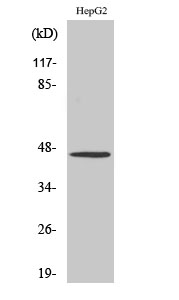SR-1A Polyclonal Antibody
- 产品详情
- 实验流程
- 背景知识
Application
| WB, IHC-P, IF |
|---|---|
| Primary Accession | P08908 |
| Reactivity | Human, Mouse, Rat |
| Host | Rabbit |
| Clonality | Polyclonal |
| Calculated MW | 46107 Da |
| Gene ID | 3350 |
|---|---|
| Other Names | HTR1A; ADRB2RL1; ADRBRL1; 5-hydroxytryptamine receptor 1A; 5-HT-1A; 5-HT1A; G-21; Serotonin receptor 1A |
| Dilution | WB~~Western Blot: 1/500 - 1/2000. Immunohistochemistry: 1/100 - 1/300. Immunofluorescence: 1/200 - 1/1000. ELISA: 1/20000. Not yet tested in other applications. IHC-P~~1:50~200 IF~~1:50~200 |
| Format | Liquid in PBS containing 50% glycerol, 0.5% BSA and 0.09% (W/V) sodium azide. |
| Storage Conditions | -20℃ |
| Name | HTR1A (HGNC:5286) |
|---|---|
| Synonyms | ADRB2RL1, ADRBRL1 |
| Function | G-protein coupled receptor for 5-hydroxytryptamine (serotonin) (PubMed:22957663, PubMed:3138543, PubMed:33762731, PubMed:37935376, PubMed:37935377, PubMed:8138923, PubMed:8393041). Also functions as a receptor for various drugs and psychoactive substances (PubMed:22957663, PubMed:3138543, PubMed:33762731, PubMed:38552625, PubMed:8138923, PubMed:8393041). Ligand binding causes a conformation change that triggers signaling via guanine nucleotide-binding proteins (G proteins) and modulates the activity of downstream effectors, such as adenylate cyclase (PubMed:22957663, PubMed:3138543, PubMed:33762731, PubMed:8138923, PubMed:8393041). HTR1A is coupled to G(i)/G(o) G alpha proteins and mediates inhibitory neurotransmission: signaling inhibits adenylate cyclase activity and activates a phosphatidylinositol-calcium second messenger system that regulates the release of Ca(2+) ions from intracellular stores (PubMed:33762731, PubMed:35610220). Beta-arrestin family members regulate signaling by mediating both receptor desensitization and resensitization processes (PubMed:18476671, PubMed:20363322, PubMed:20945968). Plays a role in the regulation of 5- hydroxytryptamine release and in the regulation of dopamine and 5- hydroxytryptamine metabolism (PubMed:18476671, PubMed:20363322, PubMed:20945968). Plays a role in the regulation of dopamine and 5- hydroxytryptamine levels in the brain, and thereby affects neural activity, mood and behavior (PubMed:18476671, PubMed:20363322, PubMed:20945968). Plays a role in the response to anxiogenic stimuli (PubMed:18476671, PubMed:20363322, PubMed:20945968). |
| Cellular Location | Cell membrane; Multi-pass membrane protein. Cell projection, dendrite {ECO:0000250|UniProtKB:P19327} |
| Tissue Location | Detected in lymph nodes, thymus and spleen. Detected in activated T-cells, but not in resting T-cells |
For Research Use Only. Not For Use In Diagnostic Procedures.
Provided below are standard protocols that you may find useful for product applications.
BACKGROUND
G-protein coupled receptor for 5-hydroxytryptamine (serotonin). Also functions as a receptor for various drugs and psychoactive substances. Ligand binding causes a conformation change that triggers signaling via guanine nucleotide-binding proteins (G proteins) and modulates the activity of down-stream effectors, such as adenylate cyclase. Beta-arrestin family members inhibit signaling via G proteins and mediate activation of alternative signaling pathways. Signaling inhibits adenylate cyclase activity and activates a phosphatidylinositol-calcium second messenger system that regulates the release of Ca(2+) ions from intracellular stores. Plays a role in the regulation of 5- hydroxytryptamine release and in the regulation of dopamine and 5- hydroxytryptamine metabolism. Plays a role in the regulation of dopamine and 5-hydroxytryptamine levels in the brain, and thereby affects neural activity, mood and behavior. Plays a role in the response to anxiogenic stimuli.
终于等到您。ABCEPTA(百远生物)抗体产品。
点击下方“我要评价 ”按钮提交您的反馈信息,您的反馈和评价是我们最宝贵的财富之一,
我们将在1-3个工作日内处理您的反馈信息。
如有疑问,联系:0512-88856768 tech-china@abcepta.com.























 癌症的基本特征包括细胞增殖、血管生成、迁移、凋亡逃避机制和细胞永生等。找到癌症发生过程中这些通路的关键标记物和对应的抗体用于检测至关重要。
癌症的基本特征包括细胞增殖、血管生成、迁移、凋亡逃避机制和细胞永生等。找到癌症发生过程中这些通路的关键标记物和对应的抗体用于检测至关重要。 为您推荐一个泛素化位点预测神器——泛素化分析工具,可以为您的蛋白的泛素化位点作出预测和评分。
为您推荐一个泛素化位点预测神器——泛素化分析工具,可以为您的蛋白的泛素化位点作出预测和评分。 细胞自噬受体图形绘图工具为你的蛋白的细胞受体结合位点作出预测和评分,识别结合到自噬通路中的蛋白是非常重要的,便于让我们理解自噬在正常生理、病理过程中的作用,如发育、细胞分化、神经退化性疾病、压力条件下、感染和癌症。
细胞自噬受体图形绘图工具为你的蛋白的细胞受体结合位点作出预测和评分,识别结合到自噬通路中的蛋白是非常重要的,便于让我们理解自噬在正常生理、病理过程中的作用,如发育、细胞分化、神经退化性疾病、压力条件下、感染和癌症。






